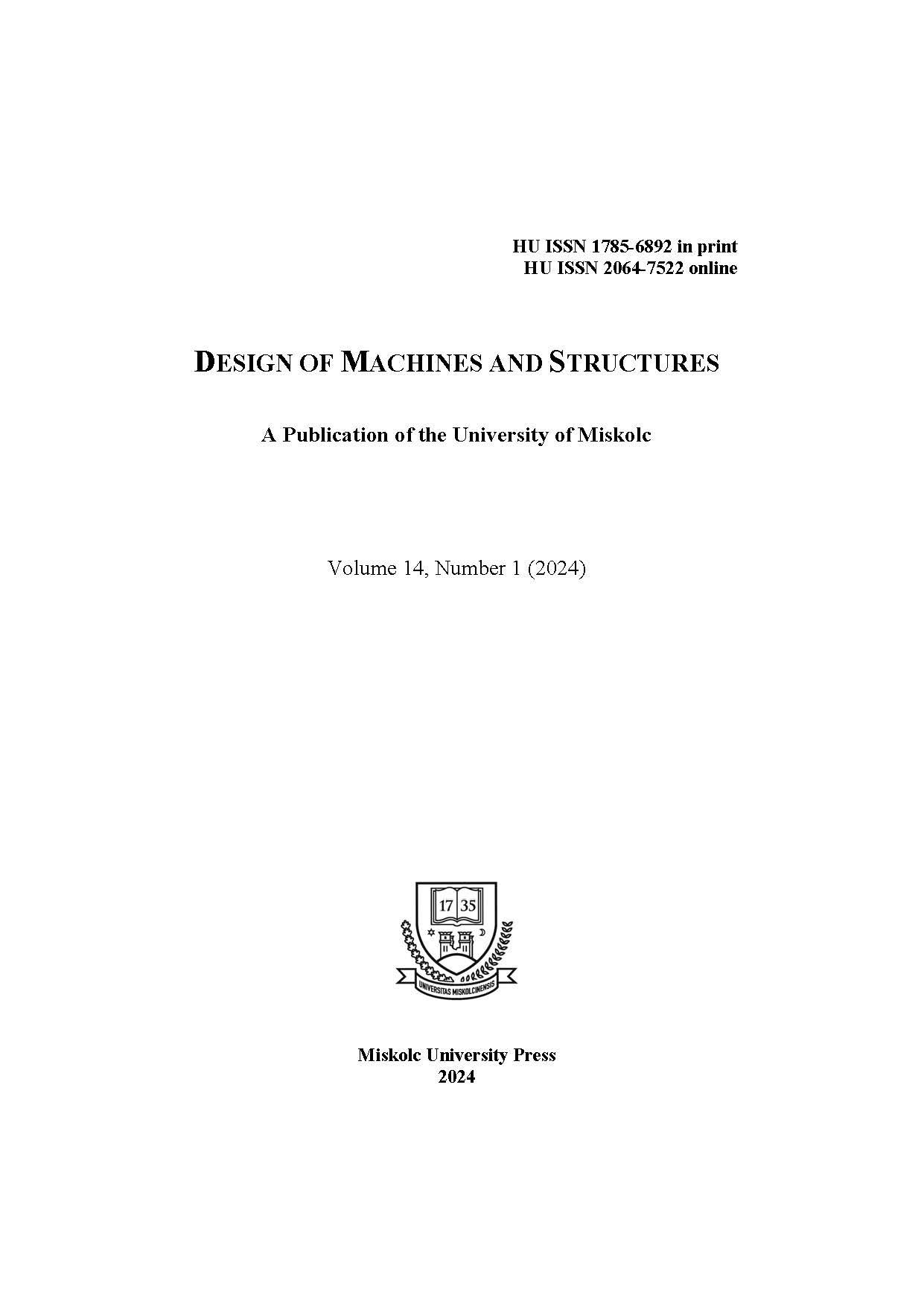ADDITIVE MANUFACTURING FROM BIOMIMETIC APPROACH
DOI:
https://doi.org/10.32972/dms.2024.001Keywords:
additive manufacturing, lattice structures, biomimicryAbstract
During the past millions of years since the beginning of our world, nature has created structures that are resistant to the various effects of the environment. However, these natural structures are quite complicated, so their production and artificial reproducibility with the tools of traditional manufacturing technology is a very difficult task. However, even complex structures can be produced relatively easily with the help of additive manufacturing. Using topological optimization techniques, lattice structure models with excellent mechanical characteristics can be created, which can be easily manufactured by exploiting the advantages of additive manufacturing. Applying natural structures (biomimetic approach) during topological optimization and produce the solution by additive manufacturing, light and high-strength structural alternatives can be created, any further structural analyses can be done.
References
Alzyod, H., & Ficzere, P. (2023). Material-Dependent Effect of Common Printing Parameters on Residual Stress and Warpage Deformation in 3D Printing: A Cromprehensive Finite Element Analysis Study. Polymers, 15(13). https://doi.org/10.3390/polym15132893
Alzyod, H., Borbas, L., & Ficzere, P. (2023). Rapid prediction and optimization of the impact of printing parameters on the residual stress of FDM-ABS parts using L27 orthogonal array design and FEA. Materials Today: Proceedings, 93, 583-588. https://doi.org/10.1016/j.matpr.2023.02.213
Briguiet, G., & Egan, P. (2020). Structure, Process, and Material Influences for 3D Printed Lattices Designed With Mixed Unit Cells. ASME 2020 International Design Engineering Technical Conferences and Computers and Information in Engineering
Conference. Virtual, online. doi:https://doi.org/10.1115/DETC2020-22575
Datta, P., Vyas, V., Dhara, S., Chowdhury, A., & Barui, A. (2019). Anisotropy properties of tissues: a basis for fabrication of biomimetic anisotropic scaffolds for tissue engineering. Journal of Bionic Engineering, 16, 842-868. https://doi.org/10.1007/s42235-019-0101-9
Dömötör, C. (2005). Natural motivations in engineering design. GÉP, 56, 25-26.
Dömötör, C. (2014). A természeti intuíció hatása a termékfejlesztés gyakorlatára. GÉP, 65(14), 23-36.
Dömötör, C., & Péter, J. (2012). Természeti elvek az analógia alapú tervezésben. GÉP, 63(12), 29-32.
du Plessis, A., Broeckhoven, C., Yadroitsava, I., Yadroitsev, I., Hands, C., Kunju, R., & Bhate, D. (2019). Beautiful and Functional: A Review of Biomimetic Design in Additive Manufacturing. Additive Manufacturing, 27, 408-427. https://doi.org/10.1016/j.addma.2019.03.033
Fernandes, M., Saadat, M., Cauchy-Dubois, P., Inamura, C., Sirota, T., Milliron, G., . . . Weaver, J. (2021). Mechanical and hydrodynamic analyses of helical strake-like ridges in a glass sponge. Journal of the Royal Society Interface, 18(182). https://doi.org/10.1098/rsif.2021.0559
Gibson, L., & Ashby, M. (1997). Cellular Solids: Structure and Properties. Cambridge: Cambridge University Press.
Hoang, V., Tran, P., Vu, V., & Nguyen-Xuan, H. (2020). Design of lattice structures with direct multiscale topology optimization. Composite Structures, 252. https://doi.org/10.1016/j.compstruct.2020.112718
Huang, H., Wang, L., & Fan, Y. (2023). Metallic meta-biomaterials: A critical review of fatigue behaviours. Journal of Science Advanced Materials and Devices, 8(3). https://doi.org/10.1016/j.jsamd.2023.100585
Kladovasilakis, N., Tsongas, K., & Tzetzis, D. (2020). Finite Element Analysis of Orthopedic Hip Implant with Functionally Graded Bioinspired Lattice Structures. Biomimetics, 5(3). https://doi.org/doi.org/10.3390/biomimetics5030044
Libonati, F., Graziosi, S., Ballo, F., Mognato, M., & Sala, G. (2023). 3D-Printed Architected Materials Inspired by Cubic Bravais Lattices. ACS Biomaterials Science and Engineering, 9(7), 3935-3944. https://doi.org/10.1021/acsbiomaterials.0c01708
Nazir, A., Abate, K., Kumar, A., & Jeng, J. (2019). A state-of-the-art review on types, design, optimization, and additive manufacturing of cellular structures. International Journal of Advanced Manufacturing Technology, 104, 3489-3510. https://doi.org/10.1007/s00170-019-04085-3
Nguyen, D. (2019). Design of lattice structure for additive manufacturing in CAD environment. Journal of Advanced Mechanical Design, Systems, and Manufacturing, 13(3). https://doi.org/10.1299/jamdsm.2019jamdsm0057
Plocher, J., & Panesar, A. (2019). Review on design and structural optimization in additive manufacturing: Towards next-generation lightweight structures. Materials and Design, 183. https://doi.org/10.1016/j.matdes.2019.108164
Seharing, A., Azman, A., & Abdullah, S. (2020). A review on integration of lightweight gradient lattice structures in additive manufacturing parts. Advances in Mechanical Engineering, 12(6), 1-21. https://doi.org/10.1177/1687814020916951
Szabó, K. (2022). Investigation of the Applicability of Topological Methods. In K. Jármai, & Á. Cservenák (Ed.), Springer. Lecture Notes in Mechanical Engineering, pp. 582-591. Vehicle and Automotive Engineering 4. https://doi.org/10.1007/978-3-031-15211-5_49
Tao, W., & Leu, M. (2016). Design of lattice structure for additive manufacturing. International Symposium on Flexible Automation, (pp. 325-332). Cleveland, USA. https://doi.org/10.1109/ISFA.2016.7790182
Voicu, A.-D., Hadăr, A., & Vlăs, D. (2021). Benefits of 3D printing technologies for aerospace. Scientific Bulletin of Naval Academy, 29, 8-16. https://doi.org/10.21279/1454-864X-21-I1-001
Yang, Y., Song, X., Li, X., Chen, Z., Zhou, C., Zhou, Q., & Chen, Y. (2018). Recent Progress in Biomimetic Additive Manufacturing Technology: From Materials to Functional Structures. Advanced Materials, 30(36). https://doi.org/10.1002/adma.201706539

